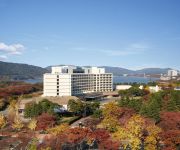Facts and Data
Webpages:
Official Unesco Page
Cultural Properties Administration
View photos from OUR PLACE the World Heritage collection
Korea Tourism Organization
Basis Data:
Unesco World heritage since: 1995
Size of heritage:
Coordinates:
Longitude: 129,350°
Latitude: 35,783°
Summary
Established in the 8th century on the slopes of Mount Toham, the Seokguram Grotto contains a monumental statue of the Buddha looking at the sea in the bhumisparsha mudra position. With the surrounding portrayals of gods, Bodhisattvas and disciples, all realistically and delicately sculpted in high and low relief, it is considered a masterpiece of Buddhist art in the Far East. The Temple of Bulguksa (built in 774) and the Seokguram Grotto form a religious architectural complex of exceptional significance.
Location on Map
Show bigger map on Openstreetmap
Seokguram Grotto and Bulguksa Temple: A UNESCO World Heritage Site in South Korea
The Seokguram Grotto and Bulguksa Temple, located in the Gyeongju region of South Korea, is a UNESCO World Heritage site that holds immense historical and cultural significance. This sacred site is a testament to the rich Buddhist heritage of the country and attracts visitors from all over the world.
History
The construction of the Seokguram Grotto and Bulguksa Temple dates back to the 8th century during the Unified Silla period. The Silla Kingdom, which ruled over the Korean Peninsula at that time, was known for its flourishing arts and culture. It was during this period that Buddhism gained prominence, and the construction of these religious structures was a reflection of the kingdom's devotion to the religion.
The Bulguksa Temple, which serves as the main entrance to the Seokguram Grotto, was built in 751 CE under the patronage of King Gyeongdeok. The temple was designed to represent the ideal Buddhist universe and was dedicated to the welfare of the nation and its people. The Seokguram Grotto, located on the slopes of Mount Toham, was built a few years later and served as a hermitage and meditation retreat for Buddhist monks.
Over the centuries, the Seokguram Grotto and Bulguksa Temple underwent several renovations and restorations to preserve their original beauty and architectural integrity. Despite facing numerous challenges, including natural disasters and invasions, these structures have managed to survive and stand as a testament to the enduring spirit of Buddhism in Korea.
Current State
Today, the Seokguram Grotto and Bulguksa Temple continue to be revered as important religious and cultural sites in South Korea. The Bulguksa Temple complex consists of several halls, pagodas, and bridges, all meticulously designed and adorned with intricate carvings and paintings. The temple's main hall, Daeungjeon, houses a statue of Buddha and is considered a masterpiece of Buddhist art.
The Seokguram Grotto, located a short distance from the temple, is a small granite structure that houses a serene statue of Buddha. The statue, known as the Seokguram Buddha, is considered one of the finest examples of Buddhist sculpture in East Asia. The grotto's design and construction demonstrate the remarkable skill and craftsmanship of the Silla artisans.
Visitors to the Seokguram Grotto and Bulguksa Temple can experience the tranquility and spirituality of these sacred sites. The serene atmosphere, combined with the stunning natural surroundings, creates a sense of peace and harmony. The site is also a popular destination for pilgrims and Buddhists seeking spiritual enlightenment.
Recognizing its historical and cultural significance, the Seokguram Grotto and Bulguksa Temple were inscribed as a UNESCO World Heritage site in 1995. This designation ensures the preservation and protection of these remarkable structures for future generations to appreciate and admire.
In conclusion, the Seokguram Grotto and Bulguksa Temple in South Korea stand as a testament to the rich Buddhist heritage of the country. With their intricate architecture, stunning sculptures, and serene surroundings, these sites continue to inspire and captivate visitors from around the world.



